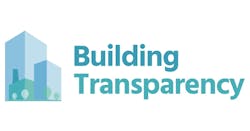Building Transparency cuts embodied carbon emissions in construction industry
Building Transparency (Seattle) recently celebrated the two-year anniversary of its nonprofit status, an important milestone for the organization's stated efforts "to reduce embodied carbon emissions and foster a better building future."
Since its founding in January 2020, the organization says it has endeavored to provide the resources and education necessary to enable embodied carbon action through its open access data and tools.
First and foremost, the nonprofit reports it has seen exponential usage and growth of its cornerstone tool, the Embodied Carbon in Construction Calculator (EC3) -- and continues to introduce new and expand upon current programs to drive awareness and enable action in addressing embodied carbon’s role in climate change.
“2021 was a monumental year for Building Transparency and for our industry at-large as we saw increased interest in understanding and reducing embodied carbon emissions in our built spaces from owners, manufacturers, designers and, notably, policymakers,” explained Stacy Smedley, executive director of Building Transparency.
Smedley added, “Leaders in the building and construction sector are prioritizing low-carbon procurement and global companies are considering their building portfolio as they set time-bound goals for reducing their carbon footprint. All of this means that our resources and tools are more important than ever as more individuals look to understand and measure their embodied carbon footprint.”
Cross-industry partnerships key
Building Transparency notes has gathered an impressive roster of more than 20 partners from global technology and sustainability companies since 2020.
This list includes organizations such as Breakthrough Energy, Microsoft, Skanska, Autodesk, Interface, Google, Amazon and Salesforce. Going forward in 2022, the nonprofit expects to add additional partner organizations from diverse industries, signaling increasing awareness and prioritization of building-related carbon emissions.
Additionally, Building Transparency has partnered with leading construction software platforms, including Autodesk Revit and BIM 360, to launch plug-ins of its EC3 tool, making it easier to look at overall embodied carbon emissions for construction projects.
In 2022, Building Transparency said will continue to explore additional integrations that will make it easier to consider embodied carbon at all stages of a project’s lifecycle.
EC3 tool enables low-carbon procurement decisions
Building Transparency manages and continues to develop its free, easy-to-use EC3 tool, designed to drive low-carbon procurement decisions to achieve zero-carbon, resilient and healthy built spaces. The tool now has more than 20,000 users from over 70 countries who are measuring, comparing and reducing the embodied carbon of their buildings. Today, EC3 supports over 2,200 building projects.
Per the nonprofit, "EC3 utilizes Environmental Product Declarations (EPDs), which are technical documents describing the environmental impact of making a product. EPDs ensure the industry has a standardized way of disclosing the environmental impacts of materials and products to enable the most carbon-conscious procurement decisions. Today, the tool contains more than 80,000 product-specific EPDs across material categories, helping users realize more reductions in embodied carbon emissions."
In 2021, the organization continued to add new material categories to the tool, including Data Cabling, Resilient Flooring, Single Ply Membrane Roofing, and Cement. In 2022, it looks to add material categories for Asphalt, Cladding and Glazing Assemblies.
In addition, Building Transparency said is focused on filling EPD data gaps in global markets, including the APAC region, where it’s welcomed the Obayashi Corporation as a pilot partner.
Program expansions continue apace
In 2021, Building Transparency launched ownersCAN (Carbon Action Network), a sister program to its materialsCAN program. These two groups bring together global leaders to address the impact of embodied carbon within the built environment sector. Members are committed to acting on the smart prioritization of embodied carbon in building materials and driving a better understanding of the carbon footprint of projects across the industry.
ownersCAN is comprised of owners, developers, users and managers of buildings who are dedicated to measuring and reducing the embodied carbon of their projects. It currently includes a group of 25 owners, with founding members including Facebook, GSA, LinkedIn and the San Francisco International Airport, who are committed to driving embodied carbon awareness, creating and sharing best practice tools, and sharing case studies of implementing strategies to reduce embodied carbon emissions.
Most recently, this includes continuing to expand its Embodied Carbon Action Plan (ECAP) with free, downloadable templates and resources. The latest addition is downloadable project specification language that makes it easier to reduce the embodied carbon of buildings during design, construction and operation.
Finally, the nonprofit noted that its materialsCAN program achieved a significant milestone at the start of 2022, whereby all its member organizations from the global building industry have either committed to or already set a Science Based Target, or a GHG reduction target that will help keep global temperatures from rising above 1.5 degrees Celsius compared to pre-industrial levels.
Notably, science-based targets include reductions in Scope 3 emissions, which includes the necessary reduction of embodied carbon of the materials they produce as manufacturers. "Having all materialsCAN members commit to targets that are science-based should inspire others in the building industry to consider evaluating their own impacts, raise their ambition, and set a target that aligns with 1.5 degrees," added the nonprofit.

